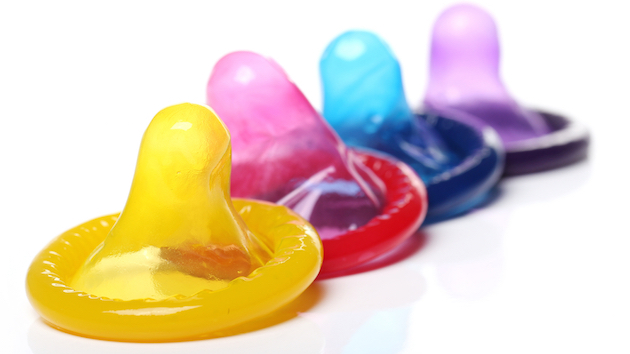
<a href="http://www.shutterstock.com/pic-101893117/stock-photo-close-up-of-colorful-condoms-over-white-background.html?src=pp-same_artist-102777911-AREwTPxPfg6zTqXkKI552Q-4&ws=1">Yeko Photo Studio</a>/Shutterstock
Dozens of porn stars—some in business casual, others more colorfully dressed—mingled outside the Elihu M. Harris State Building auditorium in Oakland, California, on Thursday morning, trading notes on the speeches they planned to make when they testified before California’s Occupational Safety and Health Standards Board (OSHA). After six years of advisory committees and meetings, the board was set to vote on a package of regulations they hoped would protect the actors against sexually transmitted infections—a measure publicized as a “condoms in porn” mandate. But workers in the porn industry opposed the rules, which they said did not account for the realities of their work or respect for their personal autonomy. The Free Speech Coalition, a porn industry trade group, brought porn stars from Los Angeles to join others from San Francisco’s kink- and gay-porn scenes in speaking out against the regulations.
“We’re not fighting safety,” Mickey Mod, a veteran porn performer and producer, told the panel. “These are our bodies, and we work with them every day. Every day, I trust the men and women who are on our side to be as safe as possible.”
Since the regulations were first proposed in 2009, some porn advocates and public-health academics have offered suggestions that they say make the rules more realistic for those in the multibillion-dollar industry. Many of them say they have felt ignored. On one draft of the regulations, the OSHA board dismissed all of the Free Speech Coalition’s 37 concerns, including objections that the measure failed to sufficiently protect workers’ medical privacy and ignored the possibility of using HIV-prevention drugs as an option for protection. “We understand that they feel it will affect their livelihood, but Cal/OSHA’s primary concern is the health and safety of workers,” an exasperated public information officer from the California Department of Industrial Relations, which includes OSHA, told me before the meeting.
A few minutes before the meeting, Eric Paul Leue, the Free Speech Coalition’s executive director, spoke privately to the workers, urging them to stay optimistic and reminding them that the OSHA board was in a difficult position. “Usually, workers and the board are fighting employers,” he said. “In this case, the workers and employers are fighting together.”
After nearly five hours of testimony, in which about 100 performers, directors, and production staff members spoke against the package of regulations—and a few former performers expressed support for it—the OSHA board struggled with the apparent contradiction of workers who were actively opposed to the OSHA protections. “I’m a labor representative. I work with working people for a living,” Dave Harrison, an OSHA board member, said. When he first heard about the regulations, “it was almost like, ‘Oh, okay, the porn industry’s coming out for an issue. What’s going to happen here?'” He chuckled. “But as the rule-making process works through, I’m actually more torn over this than I could ever explain.”
For the measure to succeed, four votes were needed, but it failed in a final vote when three board members voted for the regulations and two opposed it.
Here’s what you need to know about the proposed rules and the conflict that surrounds them:
What did OSHA propose? Some regulations already exist, but the ones that were proposed would have added a section to the OSHA code that specifically described the actions porn producers needed to take to protect workers from STIs. The regulations would have required the use of condoms, plastic barriers (known as “dental dams”) for oral sex, gloves, goggles, and other gear to block contact with bodily fluids that can carry infection. Similar requirements for all industries already exist under federal and state regulations, but they’re not well enforced. Since 2004, when OSHA began enforcing STI regulations at porn companies, they’ve only issued a handful of citations. Proponents argued that new regulations were needed to clarify the responsibilities of adult-film producers.
If condoms are already required, why is this a big deal? Because the porn industry ignores the condom requirement. Many industry workers argue that porn viewers do not “want to see dental dams, they don’t want to see gloves, they don’t want to see kissing with something in between,” explains Kevin Quintero, a cameraman for Treasure Island Media, a San Francisco-based gay-porn production studio. “That ruins their suspension of disbelief.” But if the proposal resulted in more aggressive enforcement, producers and performers say they would be forced to move away from California or to find work “underground.” Quintero says that would mean working for producers “who promote drug use, promote unsafe situations, who don’t care about their performers’ safety, usually only care about the ‘money shot’ or getting what they need. Oftentimes, it can be exploitative…I fought really hard to get out.”
What other regulations would the industry face? The proposal also would have put new testing regulations in place, requiring vaccinations and STI testing every three months. The requirements would have been less stringent than unofficial regulations that already exist in the porn industry under a system known as PASS, in which actors must pass a blood test every two weeks or they are not permitted to work. Repeatedly, performers have stressed that they feel safer having sex with other porn stars in the PASS system than they do with “civilians” outside of work. Some have also raised concerns about the possibility of confidential medical information being shared with their employers.
What’s the opposing position? OSHA argues that frequent testing isn’t the same as prevention. Several performers testified Thursday that they’d gone entire careers without contracting an STI, but past research has indicated a high rate of gonorrhea and chlamydia among performers. Earlier this month, the Centers for Disease Control and Prevention published a report documenting an incident involving male adult-film actors, in which an actor received a false-negative result on an HIV test in 2014 and then went on to infect two other people before his next testing date. Newly HIV-positive performers have forced the industry to declare periodic shutdowns, during which production is suspended for a few days while all the actors receive testing. Advocates have maintained that most infected performers do not contract HIV on set.
That’s no comfort to Sofia Delgado, one of the few performers who supported the regulations at the OSHA meeting. Delgado told me that she had been working in porn for just months when she tested positive for HIV in 2013, at age 20. Afterward, she couldn’t work, and now she says she’s saddled with thousands of dollars in medical expenses each month. “I felt so safe,” Delgado told me. “Everybody I was with was tested, but it didn’t matter.” If her partners had been using condoms, she says, she would at least be sure she didn’t contract HIV while working. Back then, PASS required testing once a month. “You’re having sex every day, so for 30 days you’re exposing God knows how many people to disease,” she said.
Additionally, the new regulations would have required producers, not actors, to pay for tests, saving employees hundreds of dollars per month—a point that none of the workers brought up in their anti-regulation presentations.
What does this mean for porn? The failure of the regulations will likely keep producers from moving out-of-state to avoid fines and hassle. After Los Angeles County passed a law in 2012 that required porn actors to wear condoms and companies to pay a fee to the county’s department of public health, the county saw a 95 percent drop-off in film production permits, which means companies either left, went “underground,” or filmed without permits.
What’s next? The fight over safe-sex precautions in porn will continue despite the defeat of the OSHA proposal. The next time it will be in the form of a proposition appearing on the 2016 California ballot. In the meantime, the OSHA regulators will go back to the drawing board—only this time, members of the board noted, they will listen more closely to the concerns of those in the industry.
Meanwhile, the AIDS Healthcare Foundation, which submitted the original petition to OSHA to amend the regulations in 2009, has also pledged to file a new petition. The foundation, which is controversial among AIDS activists for its objection to HIV-prevention medication, is also behind the statewide ballot initiative as well as several lawsuits attempting to compel condom use in porn.
“I always expect the establishment to not hear us, not respect us, not listen to us, not pay attention to our lived experience,” says Nina Hartley, a longtime performer and outspoken porn advocate. “This shows that some people are open to hearing challenging ideas and maybe changing their opinion. I don’t know if anybody on the board likes porn, but they are clearly seeing us as humans, as actual people, and not just as a projection and not a stereotype, and that’s huge.”

















